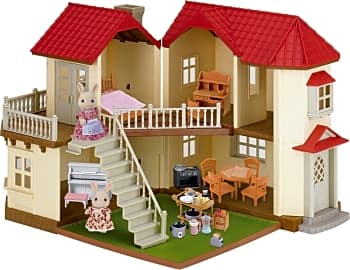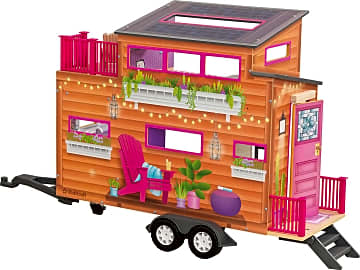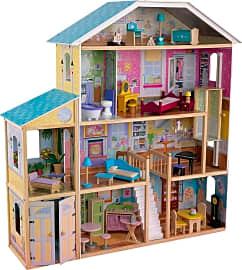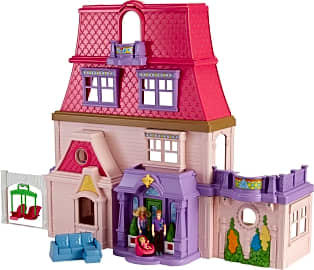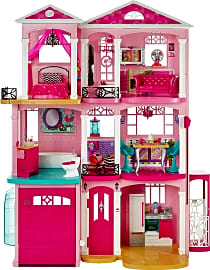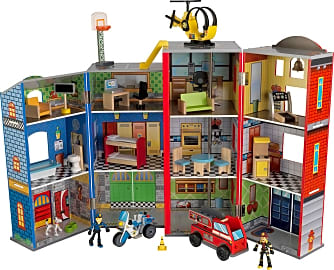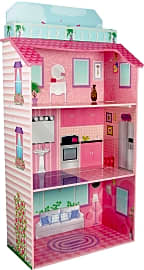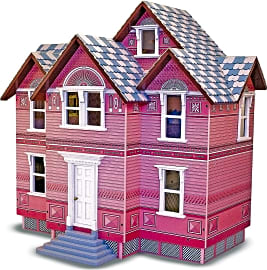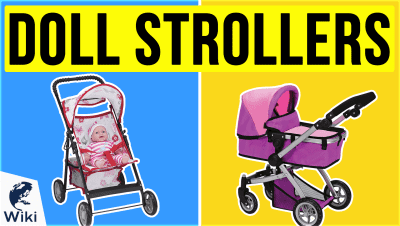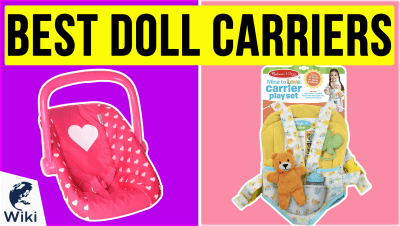The 10 Best Doll Houses

This wiki has been updated 41 times since it was first published in April of 2015. While there's something to be said for classic, Victorian-style dollhouses, you don't need ruffles and lace to have fun, as shown by the range of options on this list. From timeless wooden structures to trendy and modern portable toy dwellings, these offer hours of creative playtime for youngsters and their siblings and friends. When users buy our independently chosen editorial recommendations, we may earn commissions to help fund the Wiki.
Editor's Notes
May 31, 2019:
Joining the ranks of classics like the Barbie Dreamhouse and bustling Fisher-Price Little People sets are dollhouses that put a playful spin on a broad range of lifestyles. Alongside KidKraft's spacious Majestic Mansion are an homage to downsized domiciles and the Everyday Heroes activity center. For eco-conscious shoppers, there's the Hape All Seasons, and for animal lovers, a townhouse built for our furry friends. Sadly, the modular Maxim By You didn't make the cut due to availability issues.
Special Honors
The Little Dollhouse Company Specializing in handcrafted dollhouses and miniature accessories, The Little Dollhouse Company in Toronto, Canada is a great place to shop for the dollhouse of your wildest dreams, or pick up some fancy new furnishings for the toys' new digs. thelittledollhousecompany.com
Imagination In Many Forms
A 1:12 scale is the common size preferred by many dollhouse collectors.
Art takes many forms. It can freeze past moments in time, capture images of real people, and it can even be interactive to teach lessons while inspiring the imagination. It is this final form of interactivity and imagination that encourages the use of a dollhouse. Though it might be considered a toy geared for young girls, dollhouses also appeal to adult collectors and museums. They represent the imagination, time, and artistic expression of their designers and depict many different types of scenes with objects located in different rooms. Young girls today can certainly use contemporary dollhouses as a form of play, but such objects also let the user make up their own rules about where things should be.
The dollhouse typically depicts a miniaturized home with separate rooms ordinarily found in most life-size homes. Dollhouses often come with miniaturized figures of people, pets, furniture, and other objects that are normally found in the home and can be moved by the owner at will. The eclectic nature of a dollhouse and its purpose can be greatly influenced by its construction. Dollhouses are crafted from any range of materials that include modern plastics, metal, plywood, or elaborately-carved woods. They can be assembled by hand from a kit or they can come pre-assembled.
Dollhouses are built to a variety of scale specifications, depending on where they come from and their purpose. A majority of contemporary children's dollhouses are built to 1:18 scale for play. This means that one unit of measurement on the dollhouse (i.e. inches or centimeters) is equivalent to eighteen units of the same measurement on the original (or life-size) version. A 1:12 scale is the common size preferred by many dollhouse collectors.
So, why are dollhouses so popular for collectors and children alike? They are available in many different colors, themes, and styles. Some recreate a moment or trend from the past, affording them historical significance when studying different periods in time to get a glimpse of what life may have been like. For example, some dollhouses are recreated to look like homes from Victorian times.
These structures act as a canvas for sparking a child's imagination, allowing them to weave their own elaborate stories about the miniatures involved. Depending on how large a dollhouse is, it can be a great way to store additional toys and dolls for safekeeping. Furthermore, the larger a dollhouse is, the easier it becomes for groups of children to play together and bond as friends. If multiple children share the same interest and fascination with a particular theme, then the dollhouse will have served its purpose to bring kids closer together for play and social interaction.
A Brief History Of Dollhouses
Although it's difficult to pinpoint the exact origin for the invention of the dollhouse, history suggests that these miniature structures have been around for thousands of years. Some of the earliest examples of dollhouses (or model depictions) have been recovered from Egyptian tombs dating back almost five thousand years. These early wooden models depicted servants, animals, boats, and were thought to have been used for religious purposes.
After World War II, the mass production of dollhouses increased with less of a focus on extensive detail than before.
The first European dollhouses (also known as baby houses) appeared in the sixteenth century and took the form of hand-crafted cabinet display cases made up of individual rooms with detailed furnishings, similar to the elaborately-decorated dollhouses still seen today. These European structures were originally intended for adult collectors.
By the time of the Industrial Revolution in the latter part of the eighteenth century, mass production of dollhouses in factories became more common. By the end of the nineteenth century, dollhouses were being produced in the United States as well. Germany gained the reputation for producing and exporting the most highly-desired and elegantly-crafted dollhouses to both Britain and the United States up until World War I. After World War II, the mass production of dollhouses increased with less of a focus on extensive detail than before. By the 1950s, the majority of dollhouses were constructed from painted sheet metal (or plastic) and came with plastic furniture, similar to the modern dollhouses being sold in toy stores today.
Fulfilling Fun, Fantasy, And Possibilities
Some of the most functional dollhouses have individual rooms large enough for young girls to store their accessories and large dolls. Part of the wonder of a child's dollhouse is the ability to continue adding accessories and to share them with a large group of friends. For that reason, considering the size of your intended dollhouse and the decor of your child's room will be important considerations.
Part of the wonder of a child's dollhouse is the ability to continue adding accessories and to share them with a large group of friends.
Secondly, one must consider the age range for the dollhouse. For very small children, accessories should be large so as to minimize the chances for a choking hazard. Once a child is old enough to understand what the accessories are for and how to fully appreciate them, a more elaborate dollhouse setup will work just fine.
Just because a dollhouse is conceptually traditional is no reason it can't be equipped with modern features like built-in lights and sound effects, which many modern dollhouses are equipped with to add extra fun to the experience.
The materials should be durable, especially if a lot of kids are going to be playing with the structure on a regular basis. Heavy-duty plastic will stand up to constant use. For collectors, the best dollhouses are often made from premium-quality woods and sheet metals because they hold up so well over time.
If budget is a concern, then don't rule out purchasing a used dollhouse, either. This can be an excellent way to go, since many collectors also take pride in maintaining the quality of their miniature structures.


